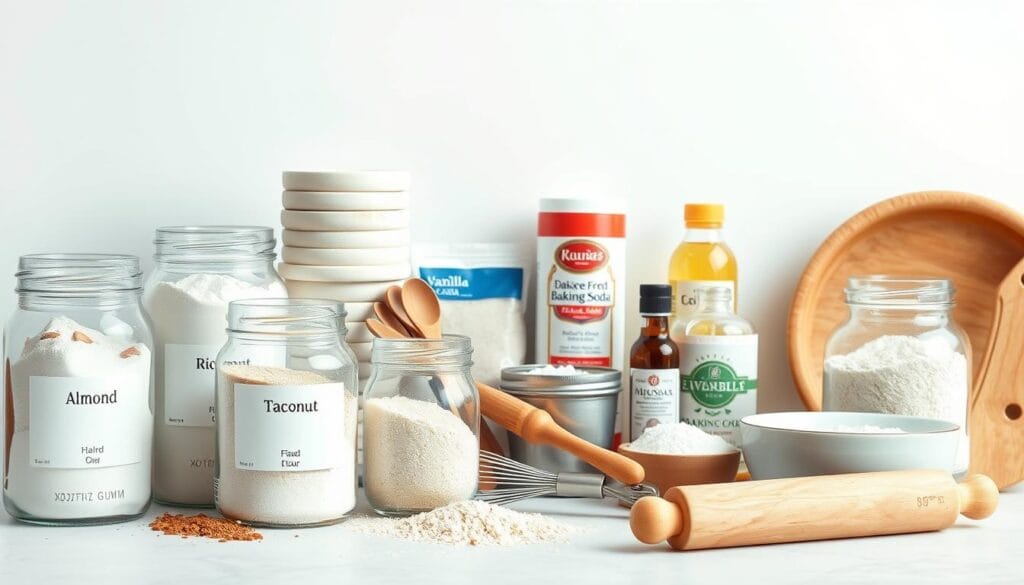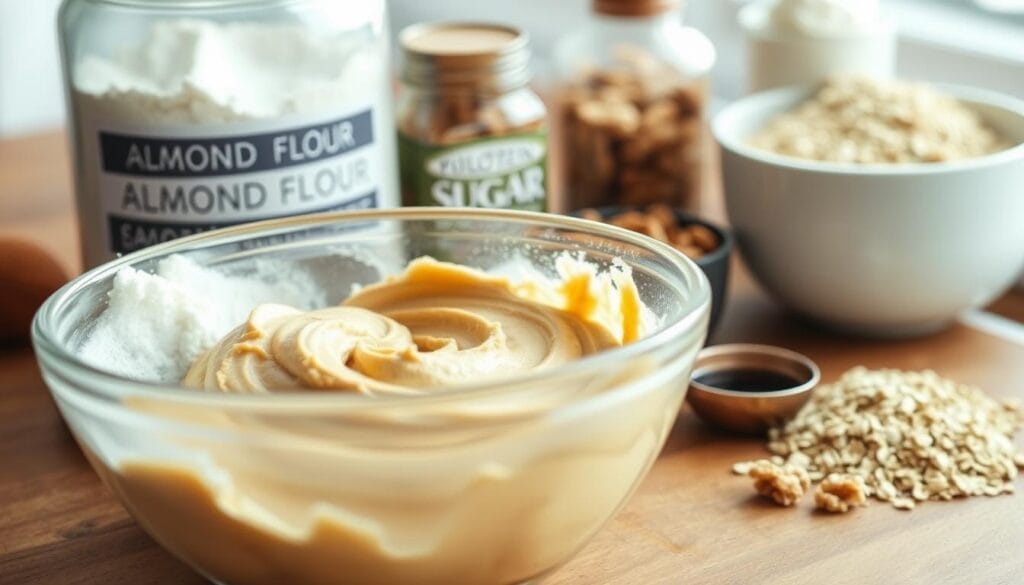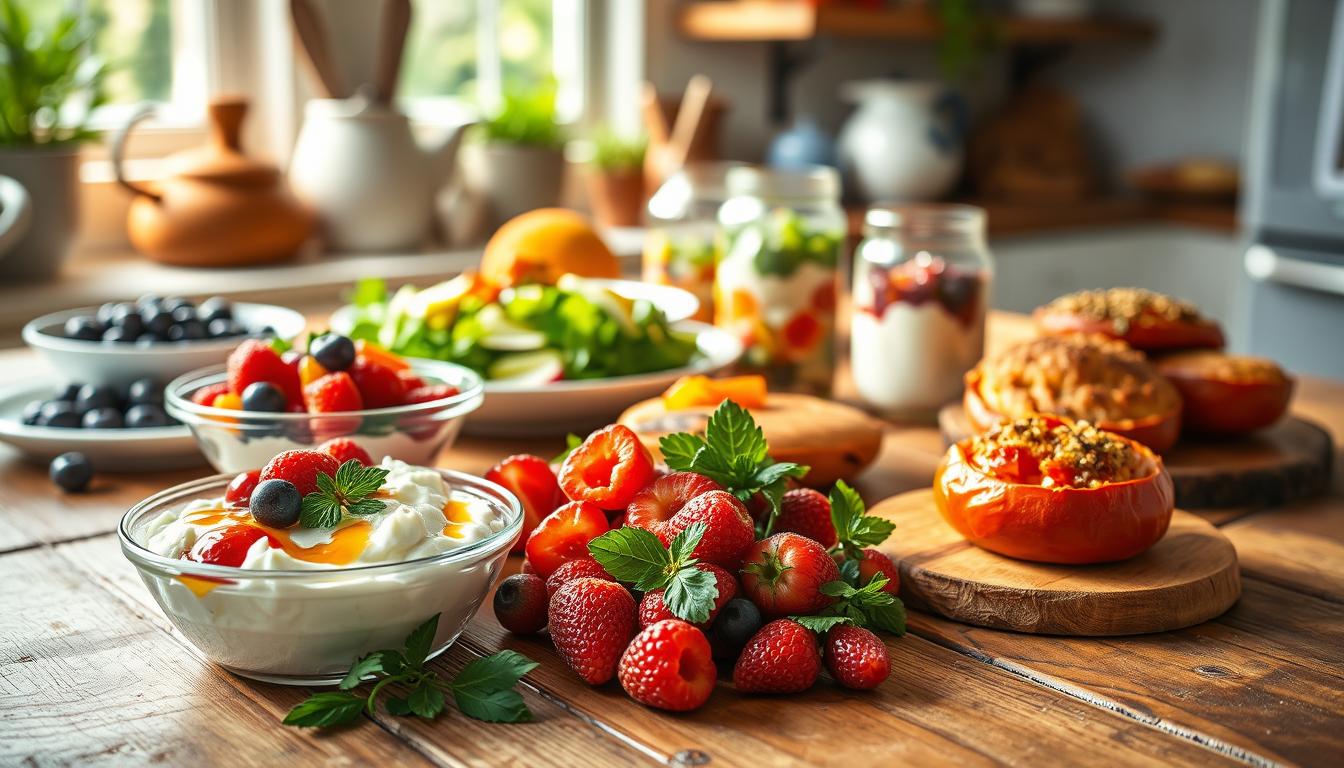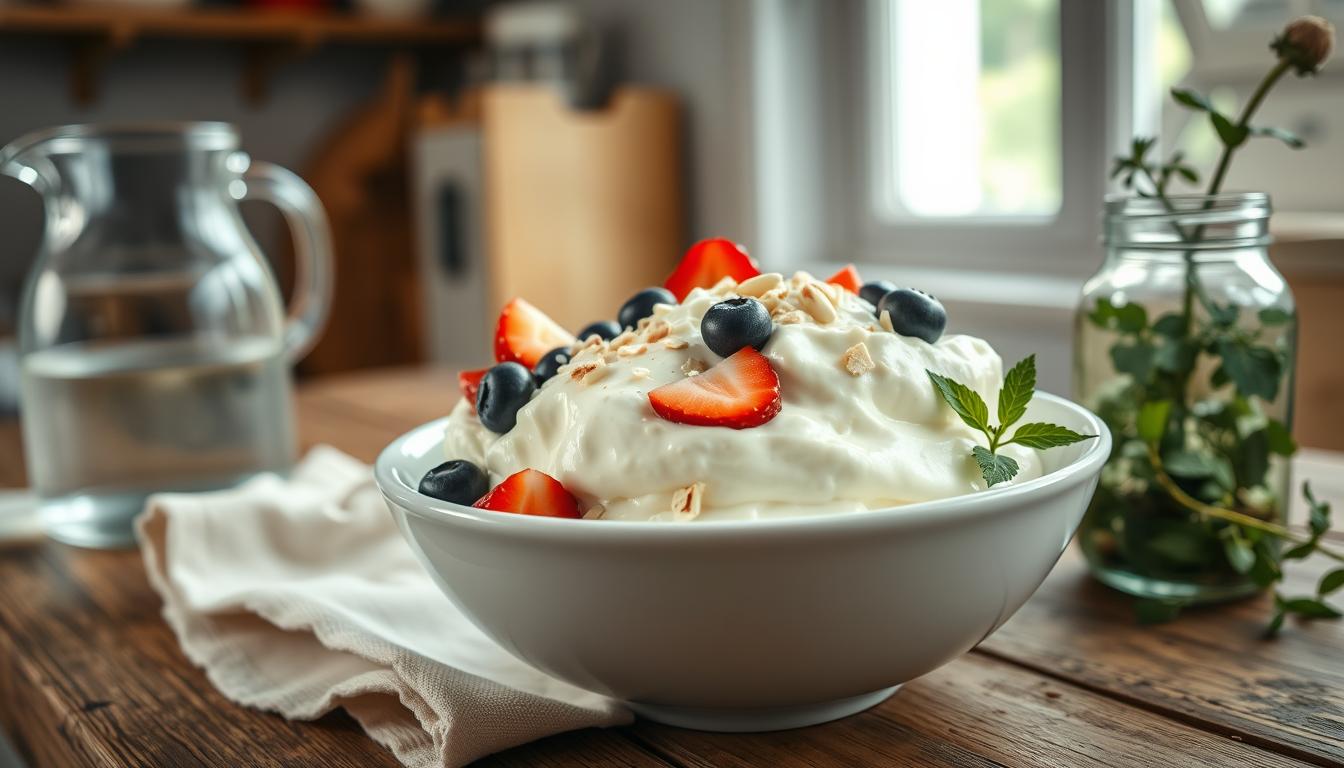Learning to make gluten free cookie dough can change your baking game. It’s all about precision, knowledge, and a bit of creativity. This guide will show you how to make the best gluten-free cookie dough, whether you’re avoiding gluten or just want to try something new.
Gluten-free baking can be tricky, but with the right steps, you can make treats that are just as good as the traditional ones. Knowing how to use gluten-free ingredients and techniques is crucial. It helps you get that perfect cookie texture and taste.
Table of Contents
Understanding Gluten-Free Baking Basics
Gluten-free baking is a world of tasty treats for those who can’t eat wheat. It’s different from regular baking because it needs special skills and knowledge. This is to get the right texture and taste.

Starting with gluten-free baking means seeing ingredients in a new way. Gluten, a protein, helps dough rise and stretch. Without it, we use other ingredients and special methods.
What Makes Gluten-Free Different
Gluten-free baking is all about finding the right flour and how to hold it together. A good recipe has:
- Several flours for the best texture
- Stuff like xanthan gum to bind
- Just the right amount of moisture
- Special mixing methods
Essential Kitchen Equipment
To bake gluten-free, you need some special tools:
- A kitchen scale for exact amounts
- Good mixing bowls
- Metal scoops for portions
- Parchment or silicone for baking
Temperature Considerations
Temperature is very important in gluten-free baking. Experts suggest:
- Bake at 350°F (175°C)
- Chill the dough to keep its shape
- Let cookies cool on wire racks
- Store them right to avoid moisture
Pro tip: Try different flour mixes to find your favorite gluten-free cookie dough!
Essential Ingredients for Perfect Cookie Dough

Making delicious gluten free cookie dough starts with the right ingredients. Your journey to making the perfect vegan cookie dough begins with understanding the essential components. These components make your treat both safe and scrumptious.
The foundation of any great gluten free cookie dough is the flour blend. You’ll want to use a combination of carefully selected gluten-free flours. This combination achieves the perfect texture and taste.
- White rice flour (46 grams)
- Potato starch (15 grams)
- Tapioca starch (8 grams)
- Xanthan gum (1 teaspoon per cup of flour)
Sweeteners play a crucial role in your vegan cookie dough. The ideal combination includes:
- Granulated sugar (25 grams)
- Light brown sugar (42 grams)
| Ingredient | Purpose | Quantity |
|---|---|---|
| Unsalted Butter | Provides richness | 56 grams |
| Vanilla Extract | Adds flavor | 15 milliliters |
| Salt | Enhances taste | 2.5 grams |
When making gluten free cookie dough, precision is key. Use a kitchen scale to measure ingredients accurately. Remember, gluten-free baking requires more attention to detail. This is to achieve the perfect texture and flavor.
Pro tip: Always heat-treat your gluten-free flour to 165°F to eliminate potential bacteria. This step takes just 20-30 seconds in the microwave at 800 watts. It ensures your cookie dough is safe to eat raw.
Choosing the Right Gluten-Free Flour Blend
Gluten-free baking can seem tricky. But, the key to making great dairy free cookie dough is picking the right flour blend. Not all gluten-free flours are the same. Knowing their differences is key to getting that bakery taste.
Store-Bought vs Homemade Blends
You have two main choices for gluten-free flour blends:
- Store-bought commercial blends
- Custom homemade flour mixtures
Commercial blends, like Cup4Cup Multipurpose Flour, are easy to use and work well every time. They’re made after lots of testing. These blends mix different starches to act like wheat flour.
Popular Flour Combinations
A good gluten-free flour blend usually has:
- White rice flour
- Brown rice flour
- Cornstarch
- Tapioca starch
- Potato starch
| Flour Brand | Key Features | Price |
|---|---|---|
| Cup4Cup | Puffy, soft texture | $17 (3 pounds) |
| Bob’s Red Mill | 1-to-1 Baking Flour | $12 (22 ounces) |
| gfJules | Top Gluten-Free Flour Award Winner | $15 (2.5 pounds) |
Understanding Flour Properties
Gluten-free flours differ a lot in texture and how they perform. A good homemade blend has more starches than whole-grain flours. Adding a bit of xanthan gum helps with binding and stretchiness.
Pro tip: Avoid flour blends with too much rice flour. They can make baked goods gritty or dry.
Finding the perfect gluten-free flour blend is all about your baking needs and taste. Try out different mixes to find what works best for you.
The Science Behind Gluten-Free Cookie Dough
Understanding the science of gluten-free cookie dough is key to making tasty treats for all. Gluten, a protein in wheat, gives baked goods their shape and texture. For those who can’t have gluten, making similar treats requires some science.
Success in gluten-free cookie dough comes from knowing how ingredients work together. Without wheat flour, you need something else to hold it together. This is where special ingredients come in:
- Xanthan gum helps mimic gluten’s structural properties
- Alternative flours like almond or coconut provide unique textures
- Binding agents ensure cookie dough holds together
Adding eggless cookie dough makes things more complicated. Without eggs, you need to pick ingredients that add moisture and stickiness. Ground flaxseed, chia seeds, or egg replacers can help keep the dough together.
Protein is very important in gluten-free baking. Wheat flour has a lot of protein that makes gluten. But other flours have different proteins. For example, almond flour has more protein but needs special handling.
The secret to perfect gluten free cookie dough is understanding how each ingredient contributes to texture and flavor.
To make great gluten-free cookie dough, remember these science tips. Try different flour mixes, binding agents, and moisture levels. This way, you can make a dough that tastes great and holds its shape well.
Mastering the Gluten-Free Cookie Dough Texture
Making the perfect gluten-free cookie dough needs skill and knowledge of how ingredients work. You must balance moisture, texture, and mixing to get a delicious dough. This dough should be as tasty as the traditional kind.
Getting the right gluten-free cookie dough texture is key. It can make or break your baking. There are several important factors to consider.
Proper Mixing Techniques
Here are the key mixing tips for gluten-free cookie dough:
- Use room temperature ingredients for the best mix
- Mix slowly to avoid overmixing
- Add dry ingredients slowly
- Use a paddle attachment for even mixing
Troubleshooting Common Texture Issues
Gluten-free cookie dough can be tricky. Here’s how to fix common problems:
| Issue | Solution |
|---|---|
| Dry, crumbly dough | Add liquid bit by bit (milk or water) |
| Thin, runny dough | Add gluten-free flour a little at a time |
| Lacks binding | Try xanthan gum (1 tsp per cup of flour) |
Achieving the Perfect Consistency
For the best healthy cookie dough, follow these tips:
- Chill the dough for 30-60 minutes before baking
- Use a mix of gluten-free flours for better texture
- Measure ingredients carefully
- Try chia seeds as a natural binder
Creating the perfect gluten-free cookie dough is a skill that takes practice. Each batch will improve your technique. You’ll learn more about gluten-free baking.
Best Sweeteners and Binding Agents
Making safe to eat cookie dough means picking the right sweeteners and binding agents. In gluten free baking, the right ingredients are key for texture and flavor.
For gluten-free cookie dough, try different sweeteners for better taste and texture:
- Natural sweeteners like honey and maple syrup
- Traditional granulated sugars
- Alternative sweeteners such as coconut sugar
- Low-glycemic options like stevia
Binding agents are crucial for gluten-free dough. They replace gluten’s structure. Your options are:
- Xanthan gum
- Chia seeds
- Psyllium husk
- Ground flax seeds
| Binding Agent | Recommended Amount | Primary Function |
|---|---|---|
| Xanthan Gum | 1/4 teaspoon per cup of flour | Provides elasticity |
| Chia Seeds | 1 tablespoon per recipe | Adds moisture and structure |
| Psyllium Husk | 1-2 teaspoons per recipe | Enhances binding properties |
Gluten free baking is all about trying new things. Start with small amounts of binding agents and adjust as needed. Your aim is to make delicious, safe cookie dough for everyone to love.
Making Perfect Gluten-Free Cookie Dough
Making gluten-free cookie dough is all about precision and technique. It’s a journey to create the ultimate gluten-free dessert. You’ll learn the key steps and how to avoid common mistakes.
Step-by-Step Mixing Process
To make the perfect gluten-free cookie dough, follow these steps:
- Heat-treat your gluten-free flour in the microwave for 1 minute, ensuring it reaches 165°F
- Cream butter and sugar together until light and fluffy
- Add vanilla extract and milk gradually
- Slowly incorporate gluten-free flour blend
- Fold in chocolate chips
Visual Cues for Success
Look for these signs when mixing your gluten-free cookie dough:
- Consistent texture: Smooth and free of lumps
- Color uniformity: Even light brown or beige appearance
- Moisture level: Slightly sticky but not wet
Common Mistakes to Avoid
Avoid these common mistakes to ensure success:
- Skipping flour heat treatment
- Overmixing the dough
- Using incorrect flour measurements
- Not chilling the dough before shaping
| Ingredient | Quantity |
|---|---|
| Butter/Coconut Oil | 2 tablespoons |
| Milk | 3-4 tablespoons |
| Sugar | 1/4 cup |
| Vanilla Extract | 1 teaspoon |
| Gluten-Free Flour | 3/4 cup |
| Mini Chocolate Chips | 1/4 cup |
Remember, practice makes perfect with gluten-free cookie dough. Each batch will improve your skills. Soon, you’ll have a foolproof method for this gluten-free dessert.
Storage and Handling Tips
Keeping your safe to eat cookie dough fresh is key. Use the right storage and handling tips. This way, your gluten-free cookie dough stays delicious and fresh for later.
Refrigeration and Freezing Strategies
Here are some ways to store your gluten-free cookie dough:
- Refrigerate dough for up to 3 days in an airtight container
- Freeze cookie dough balls for up to 3 months
- Flash freeze dough balls for 1-2 hours before long-term storage
- Use parchment paper between layers to prevent sticking
Freezing and Thawing Tips
Freezing your gluten-free cookie dough? Remember these tips:
- Thaw frozen dough for 10 minutes before baking
- Add 1-2 minutes to original baking time when using frozen dough
- Label containers with the recipe date and ingredients
- Store in single layers to maintain texture
Safe Handling Practices
To keep your safe to eat cookie dough quality high, follow these:
- Always use clean utensils when handling dough
- Keep dough refrigerated when not in use
- Avoid leaving dough at room temperature for extended periods
- Discard dough if it shows signs of spoilage
Pro tip: For crispy cookies, heat thawed cookies in a 300°F oven for 3-5 minutes before serving.
Creative Variations and Add-ins
Exploring your gluten-free dessert option can lead to amazing flavors. Mastering the basic recipe is just the start. It’s time to get creative and make your treat truly special.
Chocolate and Nut Delights
Make your vegan cookie dough even better with exciting mix-ins:
- Dark chocolate chips for rich intensity
- Chopped almonds for crunch
- Toasted pecans for depth of flavor
- Cacao nibs for a sophisticated twist
Fruity and Spicy Combinations
Try new flavors in your gluten-free dessert:
- Dried raspberry pieces for tartness
- Ground cinnamon for warmth
- Freeze-dried strawberry crumbles
- Pumpkin pie spice for seasonal flair
Special Diet Modifications
Your vegan cookie dough can fit many diets. Try these changes:
- Replace butter with coconut oil
- Use maple syrup instead of honey
- Incorporate alternative milk options
- Experiment with sugar-free sweeteners
Remember, creativity is key to amazing gluten-free cookie dough. Start with small batches and find your favorite mix!
Troubleshooting Common Problems
Gluten-free baking can be tricky, but knowing common challenges helps. You can make perfect dairy free cookie dough every time. Whether you’re new or experienced, these tips will improve your gluten-free baking.
- Cookies spreading too much during baking
- Dry or crumbly texture
- Gritty or grainy consistency
- Lack of proper binding
Pro tip: Adding an extra 1/8-1/4 cup of gluten-free flour can prevent excessive spreading. If your cookie dough is too wet, try these quick fixes:
- Chill the dough for 30 minutes before baking
- Check your oven temperature
- Adjust ingredient ratios
“Successful gluten-free baking is about understanding ingredient interactions and making smart adjustments.” – Gluten-Free Baking Experts
Texture problems can often be fixed by:
- Using a blend of gluten-free flours
- Adding binding agents like xanthan gum
- Experimenting with moisture-enhancing ingredients
With over 2 million gluten-free baking enthusiasts sharing, you’re not alone. By using these troubleshooting techniques, you’ll make delicious dairy free cookie dough that’s just as good as traditional recipes.
Conclusion
Mastering gluten-free cookie dough is an art that needs precision, creativity, and knowledge of new ingredients. Your baking journey requires patience and a willingness to try different flours and techniques. These steps help turn traditional recipes into safe, tasty treats.
The world of gluten-free cookie dough is full of possibilities for home bakers. Using flours like almond, coconut, and rice, you can make delicious cookies that fit dietary needs. It’s important to use certified gluten-free labels and avoid cross-contamination to keep your baked goods safe.
Successful gluten-free baking is about knowing how ingredients work together and being flexible. Every batch of cookie dough is a chance to get better, try new flavors, and make recipes for different diets. With practice, you’ll make gluten-free cookie dough that’s just as good as the traditional kind.
Your baking journey is just starting. Keep trying new things, experimenting, and enjoying the world of gluten-free baking!


